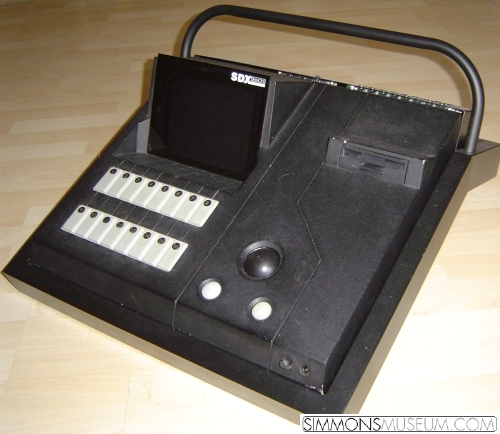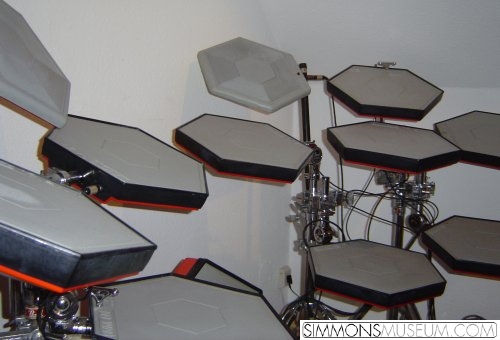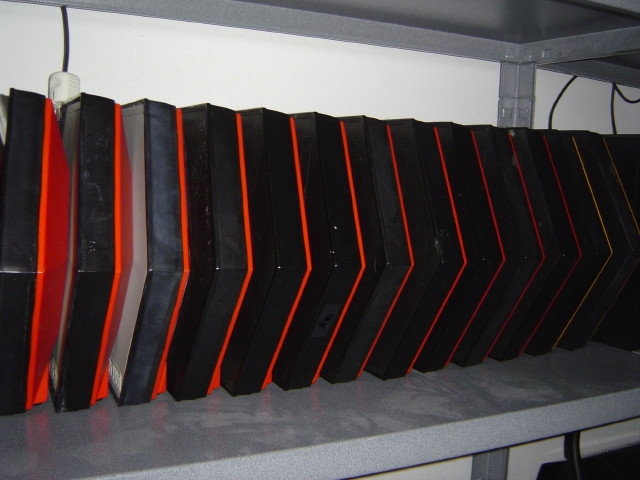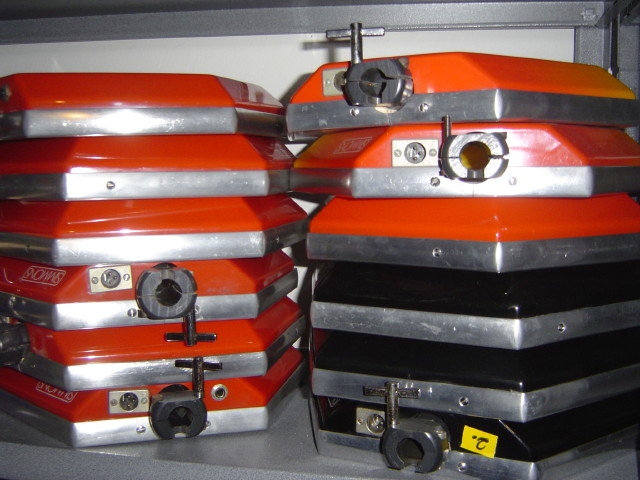I just finished editing part II:
By the way: Sibi exactly 25 years ago:
I just finished editing part II:
By the way: Sibi exactly 25 years ago:
The first snippet of my audio and video material is published on youtube
Sibi Siebert, who had the idea for this performance, obviously had a lot of fun…
The “Ludwigsburger Trommeltage“, famous drum event in Germany, has been a very entertaining event featuring (among others) Mike Terrano, Pete York, Carmine Appice and … last but not least … Sibi Siebert perfoming on a digital/analog hybrid Simmons kit, half SDSV, half SDX. Likely the first SDX live performance after at least 10 years (since Bill Bruford returned to acoustic drums and Danny Carrey changed to Mandala)

9 SDX pads plus 2 SDSV racks with 8 SDSV pads (cymbal included). He did a great show. And everything worked perfect (apart from his kick pedal and a noisy output at his sub mixer).I have a lot of audio and video material but it will take a couple of days to process all the raw material. Stay tuned!
Did the Simmons sounds become silent after the company collapsed in 1995? No, they didn’t. Ronnie Vannucci, drummer of the chart breaking US rock band The Killers just stated in an interview that the drum sound on their hit single “Human” is a result of mixing his natural drum sounds with the output of a vintage analog Simmons SDSV console.

Good choice, Ronnie! You really picked my favourite for this purpose…
Whenever I ask somebody which Simmons kit has the most appeal, he will answer “SDX”.

I remember that this was exactly my thought before I had the opportunity to bye my first one in 2003 for pretty much money. My expectations were that I’d get a piece of gear which would sound more extraodinary than I ever heard before. But I anticipate that this was not the case. When I first switched it on, got familiar with the basic functions, I tried all the kit libraries that came with the package and experienced that the SDX sounded like a common sampler. Somehow disappointing, but wait! The SDX was built in 1987, this is (from 2003) 16 years back into the past. In “computer years” this is half of an eternity. Imagine if you buy a personal computer, how long does it do its jobs before it needs to be replaced by a new one? 3 years? 5 years? My longest lasting computer was an Apple PowerMac 6100, bought in 1994, replaced in 2000. Today the SDX is even 22 years old but all of these countless innovations that streamed into this piece of history are still unique and the design is absolutely timeless. It is still good to provide a competitive sound and a few are still in use in recording studios. Bill Bruford and Danny Carey played the SDX even long time after the Simmons company collapsed. This must be love!

Next weekend I am looking forward to the “Ludwigsburger Trommeltage“. My Simmons buddy and former Simmons representative Sibi Siebert will perform on my SDX (which was his original demonstration model for the Frankfurt Music excibition back in 1988). And this is a big portion of the magic of SDX: serial number 19 of 250…
Have you noticed that the playing surfaces of most SDS9 pads sunk into the pad? The reason is simple. The SDS9 pads (Mark IV) had so called floating playing surfaces. This means the outer rubber was stuck to the edge and a thin piece of wood was glued on the bottom side without any contact to the edge. So this wooden plate was fixed only by some glue and the tension of the rubber. But over the years this rubber material becomes streched by it’s own weight with the result of a sagging surface. This phenomenon already happens if you keep your kit set up over a long period like a couple of years. The worst thing you can do is to pile your pads one upon the other because the weight affecting the rubber is even multiplied. So what is the best way to store your pads over a long time?

How about other Simmons pads?
The SDX pads react similarly, although they don’t have this “floating playing surface”, but in this case the grey rubber will even completely come of if you store them with the rubber surface to the bottom (which is ok for the Mark IV pads). It is very important that this does not happen because otherwise the FSR foil will oxidate faster. So the best ways to store SDX pads are
Mark IV and SDX are the critical pads. The SDSV pads really don’t care how you store them. They are tough enough to pile even up to 10 pads one upon the other

The same with SDS8 and early SDS7 (Mark III) pads though it’s not that easy to pile those because of the unfortunate position of the screws.
Hopefully these words help to keep some more pads in a good shape over the next years, Good night….
